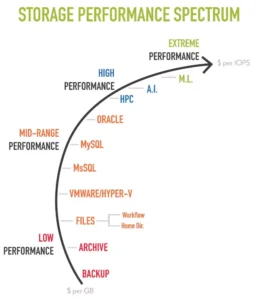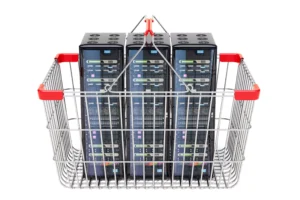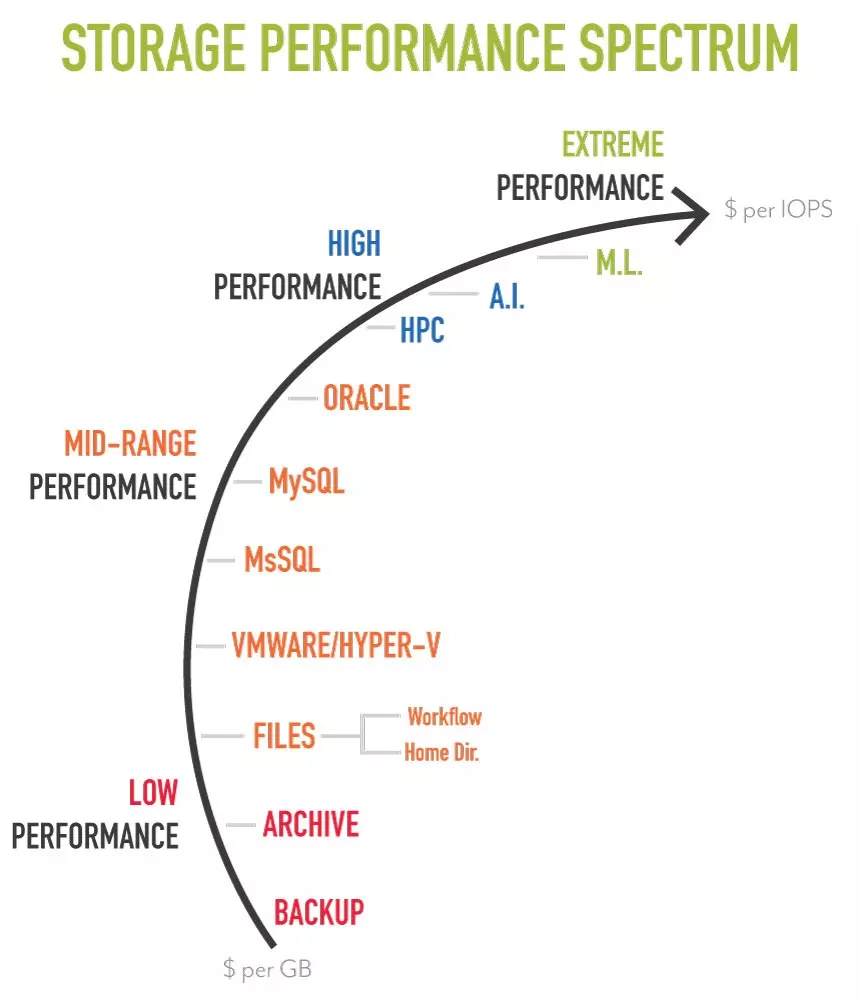Consolidating storage with Optane enables organizations to solve the single biggest challenge to a storage centralization project: workload diversity. Workload diversity creates a wide storage performance spectrum that most consolidation solutions can’t cover. Intel’s Optane Storage Class Memory solves that problem.
It provides better performance than flash and better endurance. Storage systems that integrate Intel Optane, using it as storage instead of cache, can deliver the high-performance end of the performance spectrum created by workloads like databases, commercial HPC, as well as artificial intelligence (AI) and machine learning (ML) initiatives. In this entry we resolve the issues we describe in our last entry “Storage Consolidation is Broken.”

Understanding the Performance Spectrum
The high-end of the performance spectrum is drive by $ per IOPS. However, a consolidated storage solution must also address the low-end of the performance spectrum, where $ per GB is more critical. Workloads like backup, archive, and files can still benefit from the fast access of solid-state, but the storage system must balance that benefit with a sensible price per GB.
Why All-Optane and All-Flash Can’t Consolidate
While an All-Optane solution can meet the extreme performance requirements of the upper end of the performance spectrum, it’s too expensive for its middle and lower sections of the performance spectrum because it costs too much. An All-Optane solution forces customers to buy an additional two or three other systems to meet all the requirements of all workloads. An All-Flash-Array (AFA) based on TLC flash can’t reach the extreme performance requirements of the upper end of the spectrum, and is also too expensive for the lower end of the spectrum.
Consolidating Storage with Optane Requires QLC
Consolidating storage with Optane requires the storage system to integrate with another more capacity-centric technology. QLC flash memory is the most logical companion. Intel Optane can act as a shock-absorbing storage tier, enabling the software to write to QLC sequentially, which extends durability. QLC drives also have the read performance to keep pace with Intel Optane. Most importantly, QLC technology is priced less than traditional TLC flash so organizations can afford to store petabytes of data on the tier.
Consolidating Storage with Optane Requires Tiering
The concept of moving data between tiers of storage based on age is not new and was very popular when flash first came to market. The practice of pairing flash storage with hard disk drives was commonplace, and many customers still use these systems today. AFA vendors claim that tiering was risky and unpredictable. They stated that an AFA with deduplication was a far safer choice. In fairness, there is a certain unpredictability to the performance of a flash/hard disk system. The access times are significantly different.
The answer is consolidating storage with Optane and then adding QLC to address these concerns entirely. It is critical to use Optane as storage and not as cache or the system doesn’t benefit from the primary advantages of Optane. Using Optane as flash delivers many advantage. First, reading data from the QLC tier offers no measurable performance impact to the user. Second, because the response to data access is direct from the QLC tier, there is no background overhead of rapidly promoting old data to the upper tier. Third, since access from the lower tier is at the same rate as the upper tier, the tiering process can trigger an access date instead of a modification date, making the upper-tier far more efficient. Fourth, the low-cost of QLC eliminates the need for deduplication and all its associated penalties, as we describe in our white paper “Exposing the Hidden Costs of Deduplication.”
Consolidating Storage with Optane Reduces Data Center Costs

Consolidating storage with Optane not only reduces storage costs; it has a ripple effect that reduces costs throughout the data center. From a storage perspective, a storage system that integrates Intel Optane with QLC can provide complete storage consolidation because it can cover the entire performance spectrum. The integration of Optane and QLC creates a single storage solution for the enterprise, which lowers operational overhead and improves storage efficiencies. Consolidating storage with Optane also enables organizations to drive their compute tier harder. Virtual environments are denser, and databases can scale further per database server. Also, the high write performance of Optane enables organizations to cut their database server RAM spend by 50% or more. Consolidating with Optane lowers the number of servers required for computing, and it reduces the cost of those servers. It also lowers software licensing costs.
Consolidating Storage with Optane Requires AFAn
StorONE’s All-Flash Array.next (AFAn) is an Optane-based flash array that integrates Optane with QLC to meet all the requirements of the performance spectrum. It provides very high performance and incredibly low latency at the lowest $ per IOPS in the industry. Its use of QLC enables organizations also to use AFAn for file data, archive data, and yes, even backup data. StorONE’s unique snapshot technology allows the AFAn to execute snapshots every three minutes and retain those snapshots indefinitely, eliminating the need for daily and weekly backups.
With AFAn, you can eliminate today’s storage pain point while growing into, at your pace, a storage consolidation strategy. For example, use AFAn to remove three database storage issues (data integrity, performance, and price), and in the future, expand the solution to adopt other workloads like VMware. To learn more about how AFAn can solve your database challenges check our StorONE for Database guide.
Consolidating with AFAn Eliminates Storage Migrations
The StorONE AFAn design can last for ten years or more, without the need for storage migrations. The Intel server on which our software turns into a storage controller is potent. We can support 15 to 30 petabytes of capacity and as well as extract the full performance of the next generation of Intel Optane without the need to swap out the server. When the time does come to move to the next generation of servers, you can perform the upgrade non-disruptively without a need to migrate data. Implementing an AFAn means not worrying about storage for the next decade while you simplify storage operations dramatically.




